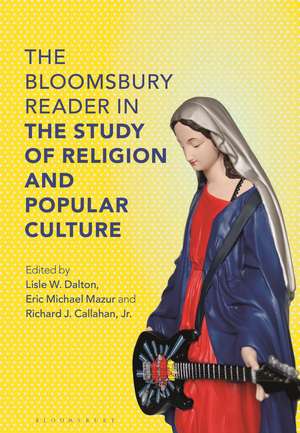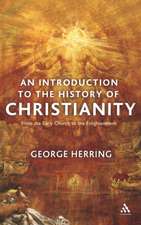The Bloomsbury Reader in the Study of Religion and Popular Culture
Editat de Lisle W. Dalton, Eric Michael Mazur, Professor Richard J. Callahan, Jr. Jr.en Limba Engleză Hardback – 12 ian 2022
| Toate formatele și edițiile | Preț | Express |
|---|---|---|
| Paperback (1) | 199.83 lei 3-5 săpt. | |
| Bloomsbury Academic – 20 sep 2017 | 199.83 lei 3-5 săpt. | |
| Hardback (1) | 571.66 lei 6-8 săpt. | |
| Bloomsbury Publishing – 12 ian 2022 | 571.66 lei 6-8 săpt. |
Preț: 571.66 lei
Preț vechi: 664.72 lei
-14% Nou
Puncte Express: 857
Preț estimativ în valută:
109.41€ • 113.92$ • 92.46£
109.41€ • 113.92$ • 92.46£
Carte tipărită la comandă
Livrare economică 07-21 martie
Preluare comenzi: 021 569.72.76
Specificații
ISBN-13: 9781472514660
ISBN-10: 1472514661
Pagini: 288
Dimensiuni: 169 x 244 mm
Greutate: 0.66 kg
Editura: Bloomsbury Publishing
Colecția Bloomsbury Academic
Locul publicării:London, United Kingdom
ISBN-10: 1472514661
Pagini: 288
Dimensiuni: 169 x 244 mm
Greutate: 0.66 kg
Editura: Bloomsbury Publishing
Colecția Bloomsbury Academic
Locul publicării:London, United Kingdom
Caracteristici
Contains discussions of both "classic" and recent readings in the field, side by side, in order to facilitate comparison while encouraging a broader methodological and historical understanding of the field itself.
Notă biografică
Lisle W. Dalton is Professor of Religious Studies at Hartwick College, USA. He is former co-chair of the Religion and Popular Culture Group of the American Academy of Religion. Eric Michael Mazur is Gloria & David Furman Professor of Judaic Studies at Virginia Wesleyan University, USA.Richard J. Callahan, Jr. is Lecturer in Religious Studies at Gonzaga University, USA. He is former co-chair of the Religion and Popular Culture Group of the American Academy of Religion.
Cuprins
AcknowledgmentsIntroductionUnit I. The Study of Religion and Popular CultureIntroduction to Unit I1. Charles Long, "Popular Religion" (2005) and David Chidester, "Planet Hollywood" (2005) Connections: TypologiesUnit II. Foundational Texts in the Study of Religion & Popular CultureIntroduction to Unit II2. Sigmund Freud: "On Dreams" (1904) and "The Psychopathology of Everyday Life" (1911) Connections: Freud, Psychoanalysis, and the Fairy Tale Connections: Freud, Cultural Critique, Self-Help, and Religionized Therapy3. Emile Durkheim: "Origins of These Beliefs" (1915) Connections: Durkheim, Memorial Day, and Civil Religion Connections: Durkheim and Totemism at the Stadium4. Max Horkheimer and Theodor Adorno: "The Culture Industry" (1944) Connections: Horkheimer, Adorno, Religion, Consumer Culture, and Advertising Connections: Horkheimer, Adorno, and Selling Religion5. Paul Tillich: "Aspects of a Religious Analysis of Culture" (1959) Connections: Tillich, Theology, and Culture Connections: Tillich and "The Gospel According to."6. Roland Barthes: "Myth Today" (1957) Connections: Barthes, Poaching, and Fandom Connections: Barthes and Religion as Critique7. Victor Turner: "Betwixt and Between" (1967) Connections: Turner and Liminal Raving Connections: Turner, Religion, Sports, and Digital Gaming8. Mircea Eliade: "The Myths of the Modern World" (1967) Connections: Eliade and the Monomyth Connections: Eliade, Myth, and the "Buddy" Genre9. Peter Berger: "Religion and World Construction" (1967) Connections: Berger and McDonald's as Sacrament of Modernity Connections: Berger and Monsters of Chaos10. Clifford Geertz: "Religion as a Cultural System" (1973) Connections: Geertz at the Movies Connections: Geertz and the American Flag as a Sacred Symbol11. Edward Said: "Introduction" from Orientalism (1978) Connections: Said, Race, & Religion Connections: Said's Orientalism, Religion, and Pop Culture12. Stuart Hall: "Notes on Deconstructing 'the Popular'" (1981) Connections: Hall, Race, Identity, and Popular Music Connections: Hall, Dominance, and Resistance through Popular Culture13. Elaine Showalter: "Feminist Criticism in the Wilderness" (1981) Connections: Showalter and the Long Arc of Joan Connections: Showalter and the Varieties of Gender Experience14. Catherine Bell: "Characteristics of Ritual-Like Activities" (1997) Connections: Bell, Religion, and Nationalism Connections: Bell and ParadesUnit III. Durable Forms in the Study of Religion & Popular CultureIntroduction to Unit III15. Who We Are: Saints, Heroes, and Monsters16. Where We Are: Sacred Space17. What We Know: Myths and Sacred Texts18. Where We Go: Pilgrimages19. What We Do: Public Ritual, Carnivals, and ParadesBibliographyIndex
Recenzii
This engaging volume demonstrates the growing sophistication of the study of religion and popular culture. It introduces a range of theorists, provides samples of their work, and puts them in a conversation about religion, the popular, and their role in society. This book provides applications to specific examples of popular culture that range from films to festivals and invites the reader to extend the discussion and explore their own examples.
This rich compilation sets the exploration of religion and popular culture in historical context and stimulates a lively contemporary discussion. Through a judicious selection of classic writings and a thematic approach to current concerns, the work provides a timely prompt for study of resources and practices that people use to make meaning and structure life. The book will stimulate a new generation of students and scholars to reflect on how religion and popular culture interweave today.
My professorial heartbeat literally quickened as I read this volume. This is THE religion and popular culture text I have been waiting for. How thrilling to have now at our fingertips what is sure to become an indispensable benchmark in the field by which others will be measured. The 'pyramid' structuring of the book's content, accompanied by the "connections and typologies" section, is highly innovative and sure to be emulated in successive works. This is a meticulously and richly layered exploration of religion and popular culture. It is not only theoretically substantive and insightful, but its approach is as fresh as it is accessible. I could not help but "binge read" this volume. The book's explication of the definitional problem of "religion," accompanied by the common-sense reminder that "religion" is indeed a popular term routinely used in the "real" world, was one of the best treatments I have read on the subject. Most intriguing is the book's third section, in which the authors explore religion through "durable forms," case studies, and a series of five open-ended questions. From saints and superheroes to vampires and zombies, students will be enthralled every step of the way in this book that is as engaging as it is erudite.
This rich compilation sets the exploration of religion and popular culture in historical context and stimulates a lively contemporary discussion. Through a judicious selection of classic writings and a thematic approach to current concerns, the work provides a timely prompt for study of resources and practices that people use to make meaning and structure life. The book will stimulate a new generation of students and scholars to reflect on how religion and popular culture interweave today.
My professorial heartbeat literally quickened as I read this volume. This is THE religion and popular culture text I have been waiting for. How thrilling to have now at our fingertips what is sure to become an indispensable benchmark in the field by which others will be measured. The 'pyramid' structuring of the book's content, accompanied by the "connections and typologies" section, is highly innovative and sure to be emulated in successive works. This is a meticulously and richly layered exploration of religion and popular culture. It is not only theoretically substantive and insightful, but its approach is as fresh as it is accessible. I could not help but "binge read" this volume. The book's explication of the definitional problem of "religion," accompanied by the common-sense reminder that "religion" is indeed a popular term routinely used in the "real" world, was one of the best treatments I have read on the subject. Most intriguing is the book's third section, in which the authors explore religion through "durable forms," case studies, and a series of five open-ended questions. From saints and superheroes to vampires and zombies, students will be enthralled every step of the way in this book that is as engaging as it is erudite.







